Content
- Characteristic
- Classification
- Deformation of the penis up
- Deformation of the penis to the sides
- Stages and degrees
- Stage of acute inflammation
- Fibrotic stage
- Symptoms and Signs
- Causes
- Diagnostics
- Shock Wave Therapy Method
- Possible consequences and complications
- Weakening of an erection
- Increased deformation
- Increased pain
- Inability to have intercourse
- Peyronie's disease videos
Peyronie's disease is an acquired male penile diseasealso known as fibroplastic induration. Treatment of this pathology involves the use of a conservative technique in the form of regular admission. anti-inflammatory and vitamin preparations, surgery or the use of shock wave therapy.
The last way to restore the physiologically normal shape of the penis is the safest, most painless and effective, but it is not performed in all medical institutions, as it requires a special medical equipment.
Characteristic
Peyronie's disease is a chronic disease in which the male penis bends in different directions under the influence of fibrotic changes in the structure of its tunica albuginea. This pathology was named after a French surgeon who, for the first time in 1743, described the symptoms of deformity changes in the penis.
Peyronie's disease occurs in men between the ages of 30 and 65. The disease can manifest itself at different stages of the patient's life, but most often occurs after a traumatic injury to the penis or under the influence of concomitant diseases of the body. The tactics of treating the disease are selected taking into account the reasons that caused it. The method of shock wave therapy is considered universal, as it has a positive therapeutic effect regardless of the etiology of the disease.
Due to the fact that not all men seek medical help with this kind of problem, scientists cannot accurately assert about the prevalence of this disease. According to preliminary estimates, it is believed that Peyronie's disease is present in 0.4-9% of the male population.
The disease is characterized by varying degrees of curvature of the penis, as well as the presence or complete lack of concomitant symptoms in the form of pain, discomfort during erection, sexual dysfunction. In medical practice, there are occasional cases when acquired Peyronie's disease progressed, and deformational changes in the penis were aggravated.
Classification
Peyronie's Disease (Shockwave therapy allows the penis to be aligned without surgical intervention) is classified into 2 main types, which are divided by nature curvature of the penis.
Deformation of the penis up
This type of curvature of the penis occurs due to the formation of fibroblastic plaque in the center of the genital organ. In this case, up to half of its length, the penis has an even shape, and then sharply bends with the head upward. Pathology can be seen only in those moments when the penis is in a state of erection.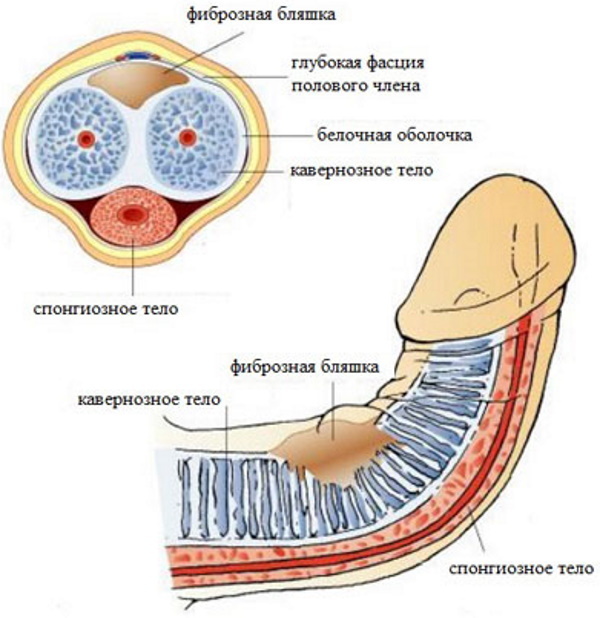
This type of disease almost never creates significant discomfort, allows a man to have an active sex life without any unpleasant symptoms. Penis deformations with upward curvature are much easier to treat with surgery and shock wave therapy.
Deformation of the penis to the sides
This type of curvature of the genital organ differs in that the penis is deformed towards the right or left side. In this case, the degree of slope can vary from 5-10 to 60 units. In most cases, the deformation of the penis to the sides becomes the reason that the man experiences not only psychological discomfort, but also feels problems with intercourse, periodically feels pain and is faced with erectile dysfunction. 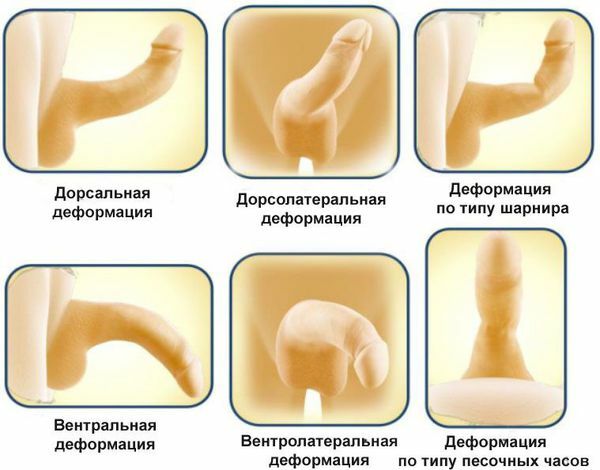 Despite this, modern medicine can equally effectively treat the lateral curvature of the penis with full alignment of its tissues.
Despite this, modern medicine can equally effectively treat the lateral curvature of the penis with full alignment of its tissues.
Stages and degrees
Peyronie's disease (treatment with shock wave therapy is carried out by a qualified physiotherapist) is divided into 2 stages of the course. This is a period of acute inflammation and a further phase of fibrotic changes in the structure of injured tissues. Moreover, these stages are always present, regardless of the etiology of the disease.
Stage of acute inflammation
During this period, the protein membrane of the penis is injured, as a result of which acute inflammation develops without signs of infectious tissue damage. The occurrence of this process can be caused by mechanical injury to the penis, autoimmune effects, or the presence of concomitant diseases of the endocrine and cardiovascular systems.
In most clinical cases, the stage of acute tissue inflammation is accompanied by periodic bouts of aching pain, which is localized in the area of fibroblastic plaque formation. At this stage, the man for the first time discovers that his genital organ has acquired signs of deformational changes with curvature upward, to the right or left. The average duration of the acute inflammation phase is 3 to 12 months. depending on the individual characteristics of the male body.
Fibrotic stage
At this stage, the physiological process of formation of a dense plaque is completed, which is easy to detect during palpation of the penis. This formation has a benign nature of origin, and its calcification indicates the stabilization of the disease. By its etiology, the fibrotic stage is the logical conclusion of the acute phase of the inflammatory process. The density and volume of fibrotic plaque depend on the nature of the injury to the penis and the extent of tissue damage that preceded the inflammation.
The main danger of the fibrotic stage of Peyronie's disease is the significant risk of further progression of this disease. According to the results of recent studies, in 47-67% of men, there is a stabilization of the pathological process in the structure of the genital organ.
At the same time, the remaining 30-50% of patients are diagnosed with a further worsening of the disease with the addition of an appropriate symptoms in the form of spontaneous attacks of pain, erectile dysfunction, progression of deformation changes with increasing degrees curvature. A sudden improvement in the clinical situation occurs in only 3-13% of men who are faced with a similar pathology.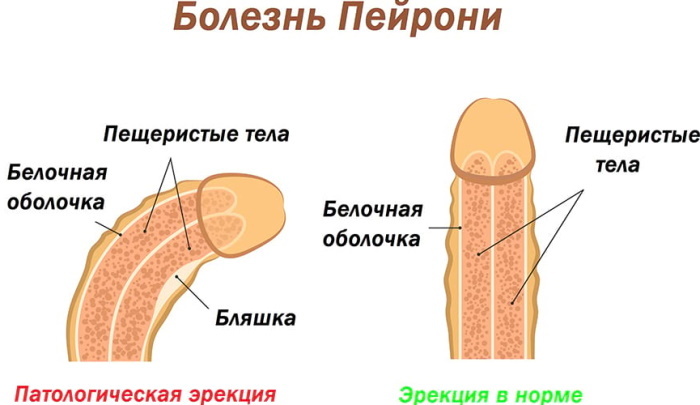
After complete calcification of the plaque in the area of injured tissues, spontaneous elimination of penile deformity practically does not occur. A similar outcome is possible only if the damage to the protein membrane of the penis was insignificant, and in as a result of the inflammatory process, a calcified plaque of low density and small sizes. In this case, it can be assumed that after stopping the focus of inflammation, the patient's body independently dissolves the formed calcifications and regenerates the injured tissues.
The following degrees of severity of Peyronie's disease are distinguished:
- easy with a curvature of the penis up to 30 degrees and the presence of a fibrous plaque no more than 2 cm;
- medium with a deformation of the penis from 30 to 60 degrees and a calcified seal from 2 to 4 cm;
- severe with an angular inclination of the genital organ over 60 degrees and a plaque diameter of more than 4 cm.
Mild Peyronie's disease can be asymptomatic with minimal risk of associated complications. Severe penis deformity requires qualified treatment using combination therapies.
Symptoms and Signs
Peyronie's disease (treatment with shock wave therapy is carried out after a preliminary examination of the male genital organ) is an acquired disease of various etiologies, which is characterized by the following symptoms:
- curvature of the penis during erection upward towards the surface of the abdomen, to the right or left sides, depending on which part of the penis was injured;
- burning, sharp or aching pain in the area of formation of fibrous tissue, which appeared as a result of acute inflammation;
- the presence of a dense or softer fibrotic plaque that is easily detected by palpation, and in some cases is visible visually (an extraneous neoplasm protrudes above the general contour of the penis, resembling a small tubercle);
- complete or partial erectile dysfunction (occurs in about 30% of men with Peyronie's disease);
- there are mechanical inconveniences during intercourse, which are caused by severe curvature of the penis (men with lateral deformation of the penis most often face this symptom).
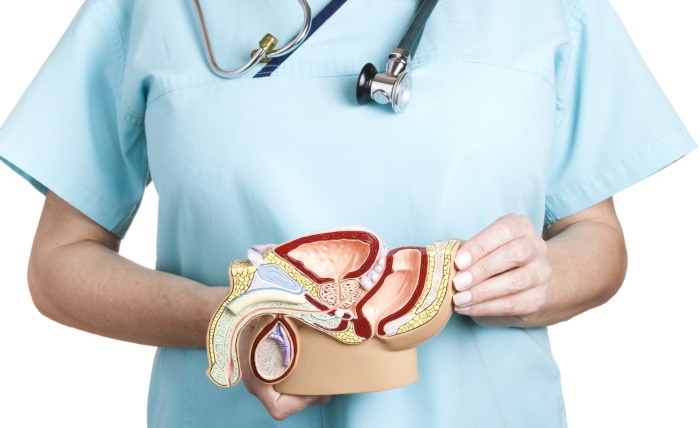 Depending on the reasons that caused this pathology, the above symptoms of Peyronie's disease can remain at the same level, or they can constantly progress, significantly reducing the quality of life men.
Depending on the reasons that caused this pathology, the above symptoms of Peyronie's disease can remain at the same level, or they can constantly progress, significantly reducing the quality of life men.
Causes
Peyronie's disease (treatment with shock wave therapy is carried out in short courses) is a disease, the nature of the origin of which has not yet been studied. Urologists cannot give an unambiguous answer, for what reasons, in men of different age groups, there is a sudden inflammation of the protein membrane of the penis. Moreover, in medical practice, there are a large number of cases when the formation of a calcified fibrotic plaque occurred without prior injury to the genital organ.
Scientists identify the following factors that contribute to the development of this disease:
- recurring local trauma to the protein membrane, which is located on top of the corpora cavernosa of the penis;
- an autoimmune reaction of the body, when acute inflammation of a certain tissue site begins suddenly, and its cause is an attack on the immune system's own cells;
- the increasing proliferation of individual fibroblasts located in the outer protein membrane of the penis;
- too active deposition of fibrin and collagen (these biologically active substances accumulate in the area of a certain area of the penis, causing the formation of a dense plaque);
- remodeling of penile tissue into a solid fibrous mass due to chronic inflammation of the penis that persists on over a long period of time (under the influence of the same factor, the concomitant process of curvature of the shape of the cavernous bodies);
- complications of diabetes mellitus, when local foci of inflammation in the tissues of the penis are caused by high glucose levels and damage to blood vessels by sugar microcrystals;
- disorders of fat metabolism;
- hypertonic disease;
- alcohol abuse;
- tobacco smoking;
- coronary heart disease.
Clinical studies show that, on average, 3 to 39% of men with Peyronie's disease have a congenital pathology in the form of Dupuytren's contracture. In this regard, it can be concluded that deformational changes in the shape of the penis are partially associated with the genetic predisposition of the male body to the occurrence of such a disease.
Diagnostics
A preliminary diagnosis is made by a urologist or surgeon after examining the patient's penis in an erect state. If there is a suspicion of Peyronie's disease, the doctor assigns the man to undergo hardware diagnostics, the methods of which are described in the table below.
| Examination type | Characteristics of the diagnostic process |
| Ultrasound | An ultrasound examination of the tissues of the penis allows you to confirm or deny the presence of a fibrotic plaque, to estimate its size, density, and the stage of calcification. This diagnostic method is considered one of the most informative. Penile ultrasound does not cause pain or discomfort. The average examination duration is 10-15 minutes. The cost of this diagnostic method is about 1600 rubles. |
| Cavernosography |
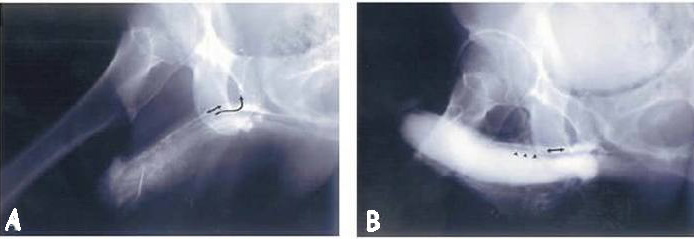 Cavernosography is a type of radiography that allows you to fix the size and location of the fibrous neoplasm that caused deformation changes in the penis. Depending on the type of curvature of the penis, an X-ray in several projections may be prescribed after injection of a contrast agent. For example, frontal imaging and lateral cavernosography. The average cost of this diagnostic method ranges from 1850 to 2445 rubles. depending on the complexity of the clinical case. Cavernosography is a type of radiography that allows you to fix the size and location of the fibrous neoplasm that caused deformation changes in the penis. Depending on the type of curvature of the penis, an X-ray in several projections may be prescribed after injection of a contrast agent. For example, frontal imaging and lateral cavernosography. The average cost of this diagnostic method ranges from 1850 to 2445 rubles. depending on the complexity of the clinical case. |
Palpation of the erect penis reveals the presence of a calcified or still soft fibrous plaque. Based on the results of the diagnosis, the doctor selects a treatment tactic that will be most effective, but at the same time minimally traumatic for the patient's genital organ.
Shock Wave Therapy Method
Conservative therapy for Peyronie's disease using vitamin E and other drugs effective only in the first 4 months, when the tissues of the man's penis are affected by acute inflammatory process. Highly dense calcified plaques can be removed using shock wave therapy. This is a modern and effective way of treating deformational changes in the structure of the protein membrane of the penis.
Conducting shock wave therapy for Peyronie's disease involves the following algorithm of actions:
- The patient goes to the sterile conditions of the physiotherapy room, which is equipped for the treatment of pathological conditions of the body using a shock wave technique.
- The man takes off his underwear, completely exposing the intimate area of the body, and then lies down on the couch. The patient lies on his back, on the right or left side, depending on the nature of the deformation curvature and the localization of the fibrous plaque.
- The doctor conducting the therapeutic procedure has a shock wave treatment apparatus at a distance of 2-3 cm from the area of the penis containing the calcified neoplasm.
- After completing all the preparatory procedures, the doctor turns on the therapeutic device into the network.
- Under the influence of high-frequency waves, there is a gradual destruction of the fibrous plaque without injury to the healthy tissues of the penis.
- The excised calcifications are naturally removed from the male by the metabolic process.
- At the end of the shock wave therapy session, the patient gets up, dresses and can independently leave the walls of the clinic.
The average duration of one treatment session using this technique is from 10 to 20 minutes. depending on the complexity of the clinical case. The destruction of the calcified plaque using the method of shock wave therapy is carried out no more than once a week. Abuse of this method of treatment can cause swelling of nearby tissues, as well as cause local inflammation.

The duration of the therapeutic course depends on the complexity of the clinical case, the degree of curvature of the penis. Medical practice shows that for the complete removal of the calcified plaque and restoration of the normal shape of the penis, 7 to 10 procedures of shock wave therapy are enough. The average cost of this method of treatment is 2,000 rubles. The advantage of using shock wave therapy is its absolute safety, the absence pain and severe complications that may arise after surgical treatment of this pathology.
Possible consequences and complications
The main danger of Peyronie's disease is that this urological pathology can progress, causing not only painful sensations, but also negative consequences for the male body.
Weakening of an erection
Severe Peyronie's disease can cause a significant decrease in erection, or cause its complete absence. The occurrence of this complication is due to the fact that the damaged protein membrane of the penis does not contract at the time of sexual arousal. At the same time, having intercourse with a weakly erect penis increases the risk of repeated injury to the genital organ with the occurrence of even larger ruptures of the protein membrane.
Increased deformation
In urological practice, there are cases when the curvature of the genital organ remains stable for decades. A man with moderate to severe penile deformity is at risk of progressively worsening the disease. Further progression of the disease with a curvature of the penis upward, to the right or left side is not excluded.
Increased pain
As Peyronie's disease worsens with an increase in the angle of curvature of the penis, discomfort may increase. This will lead to the fact that at the time of sexual arousal, the man will experience severe pain in the area of the calcified plaque. In the absence of an erection, the feeling of discomfort is not manifested.
Inability to have intercourse
The progression of deformational changes in the structure of the penis can lead to the fact that a man will lose the physical ability to have sexual intercourse due to severe curvature of the genital organ. Elimination of this complication of Peyronie's disease is possible with the help of the method of surgical or shock wave therapy. Similar consequences are found in patients with penis deformity over 60 degrees and the presence of a calcified plaque with a diameter of more than 4 cm.
Shockwave therapy is used to safely and effectively treat Peyronie's disease. This is an acquired urological pathology that occurs due to injury to the outer protein membrane of the penis, or is caused by non-infectious tissue inflammation. In most cases, Peyronie's disease is diagnosed in young men who are sexually active.
The main symptom of this disease is a deformational curvature of the penis with its direction upward or to the sides. These changes are visible only when the member is in an erect state. Treatment of Peyronie's disease is indicated for men who have a curvature of the penis exceeding 60 degrees, there are painful sensations, difficulties with intercourse, and an erection is impaired.
Peyronie's disease videos
Important points to know about Peyronie's disease:
